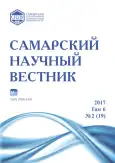Чужеродные растения в лесных сообществах Среднего Поволжья: способы диссеминации и степень натурализации
- Авторы: Саксонов С.В.1, Раков Н.С.1, Васюков В.М.1, Сенатор С.А.1
-
Учреждения:
- Институт экологии Волжского бассейна РАН
- Выпуск: Том 6, № 2 (2017)
- Страницы: 78-83
- Раздел: 03.02.00 – общая биология
- URL: https://journals.rcsi.science/2309-4370/article/view/21801
- DOI: https://doi.org/10.17816/snv201762115
- ID: 21801
Цитировать
Полный текст
Аннотация
В лесных сообществах лесостепной зоны Среднего Поволжья (в пределах Пензенской, Самарской и Ульяновской областей) встречается 60 чужеродных видов сосудистых растений. Натурализовались в лесах 25 видов адвентивных растений (42%), из них 7 видов эпекофитов (Cotoneaster lucidus, Oenothera biennis, O. rubricaulis, O. villosa, Populus suaveolens, Ulmus minor, Xanthoxalis stricta) и 18 видов агриофитов (Acer negundo, Amelanchier spicata, Bidens frondosa, Caragana arborescens, Conyza canadensis, Echinocystis lobata, Heracleum sosnowskyi, Impatiens parviflora, Fraxinus lanceolata, F. pennsylvanica, Lonicera tatarica, Lupinus polyphyllus, Malus domestica, Parthenocissus inserta, Salix euxina, Sambucus racemosa, S. sibirica, Ulmus pumila). К видам-трансформерам относятся как древесные - Acer negundo, Fraxinus lanceolata, F. pennsylvanica, Parthenocissus inserta, Ulmus pumila, так и травянистые растения - Bidens frondosa, Conyza canadensis, Echinocystis lobata, Heracleum sosnowskyi, Impatiens parviflora. Внедрение чужеродных деревьев и кустарников в леса может способствовать образованию ими плотных зарослей, нарушать ход возобновления подлеска и роста основных лесообразующих пород, а также негативно влиять на травянистый ярус. Наиболее уязвимы для внедрения адвентивных растений окраины лесных массивов, обочины дорог, а также те места, где лесные массивы прилегают к населенным пунктам. Внедрение чужеродных растений в лесные сообщества происходит в результате орнитохории (33 вида; 54%), анемохории (11 видов; 18%), антропохории (8 видов; 13%) или при сочетании различных способов заноса.
Полный текст
Открыть статью на сайте журналаОб авторах
Сергей Владимирович Саксонов
Институт экологии Волжского бассейна РАН
Автор, ответственный за переписку.
Email: svsaxonoff@yandex.ru
доктор биологических наук, профессор, заместитель директора по научной работе, заведующий лабораторией проблем фиторазнообразия
РоссияНиколай Сергеевич Раков
Институт экологии Волжского бассейна РАН
Email: torbokonfer@yandex.ru
кандидат биологических наук, доцент, научный сотрудник лаборатории проблем фиторазнообразия
РоссияВладимир Михайлович Васюков
Институт экологии Волжского бассейна РАН
Email: vvasjukov@yandex.ru
кандидат биологических наук, научный сотрудник лаборатории проблем фиторазнообразия
РоссияСтепан Александрович Сенатор
Институт экологии Волжского бассейна РАН
Email: stsenator@yandex.ru
кандидат биологических наук, старший научный сотрудник лаборатории проблем фиторазнообразия
РоссияСписок литературы
- Цвелев Н.Н. Определитель сосудистых растений Северо-Западной России (Ленинградская, Псковская и Новгородская области). СПб.: Изд-во СПХФА, 2000. 781 с.
- Шварц Е.А., Белоновская Е.А., Второв И.П., Морозова О.В. Интродуцированные виды и концепция биоценотический кризисов // Успехи современной биологии, 1993. Т. 113, № 4. С. 387-400.
- Васюков В.М. Растения Пензенской области (конспект флоры). Пенза: Изд-во Пенз. ун-та, 2004. 184 с.
- Раков Н.С., Саксонов С.В., Сенатор С.А., Васюков В.М. Сосудистые растения Ульяновской области. Флора Волжского бассейна. Т. 2. Тольятти, 2014. 295 с.
- Саксонов С.В., Сенатор С.А. Путеводитель по Самарской флоре (1851-2011). Флора Волжского бассейна. Т. 1. Тольятти: Кассандра, 2012. 512 с.
- Сенатор С.А., Саксонов С.В., Раков Н.С., Васюков В.М., Иванова А.В., Сидякина Л.В. Сосудистые растения Тольятти и окрестностей (Самарская область) // Фиторазнообразие Восточной Европы. 2015. Т. 9, № 1. С. 32-101.
- Левина Р.Е. Плоды. Морфология, экология, практическое значение. Саратов: Приволж. кн. изд-во, 1967. 215 с.
- Левина Р.Е. Морфология и экология плодов. Л.: Наука, 1987. 160 с.
- Виноградова Ю.К., Майоров С.Р., Хорун Л.В. Черная книга флоры Средней России (Чужеродные виды растений в экосистемах Средней России). М.: ГЕОС, 2009. 494 с.
- Сенатор С.А., Саксонов С.В., Васюков В.М., Раков Н.С. Инвазионные и потенциально инвазионные растения Среднего Поволжья // Российский журнал биологических инвазий. 2017. № 1. С. 57-69.
- Раков Н.С. Флора города Ульяновска и его окрестностей. Ульяновск, 2003. 216 с.
Дополнительные файлы






